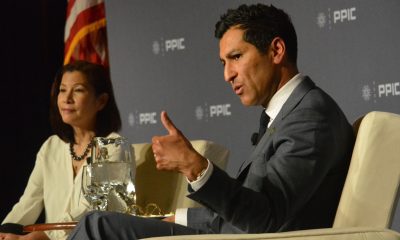Health
Washington, Others Will Treat e-Cigarettes as Drug Paraphernalia

This June 12, 2013, file photo shows a person posing with an electronic cigarette, or e-cigarette. (AP Photo/Tim Ireland, PA)
RICHMOND, Va. (AP) – Some schools are getting tougher on e-cigarettes, even punishing possession of the devices more harshly than regular cigarettes.
The devices, which heat a nicotine solution to create a vapor instead of burning tobacco, have passed traditional smokes in popularity among teenagers. Schools are clamping down because e-cigarettes, sometimes also known as vaporizers, can also be used for illegal substances like marijuana.
Most schools have folded e-cigarettes into their anti-tobacco policies, which typically punish students with detention, a letter home and sometimes a tobacco education class.
But other schools in states including North Carolina, New Jersey, Washington and Connecticut, are grouping the devices in with bongs and pipes, meaning students could face long suspensions and required drug tests and have possession of drug paraphernalia marked on their school record.
“Our goal is to reduce access and discourage use on campus,” said Sarah D’Annolfo, dean of students at The Taft School in Watertown, Connecticut.
The co-ed boarding school amended its policy this school year to have e-cigarettes fall under its drug and alcohol policy. A disciplinary committee made up of faculty and students evaluate violations case-by-case, but they could result in a weeklong suspension and a mark on their record rather than a chat with the dean and school doctor and parental notification.
“It definitely sparks conversation within the school community about e-cigarette use and the possible dangers and the possible benefits,” D’Annolfo said. “That conversation alone is a hugely important learning opportunity.”
According to an annual government survey of more than 41,000 students, e-cigarettes have surpassed traditional smoking in popularity among teens.
Some 16 percent of 10th-graders had tried an e-cigarette in the past month, and 17 percent of high school seniors. Regular smoking continued inching down, to 7 percent of 10th-graders and 14 percent of 12th-graders. However, the survey didn’t ask about repeat use, or whether teens were just experimenting with something new.
Most agree it should be illegal to sell e-cigarettes to kids, and most states have banned such sales. But health and public policy experts can’t say for certain whether the electronic devices are a good thing or a bad thing overall, whether they help smokers kick the habit or are a gateway to ordinary paper-and-tobacco cigarettes.
Nevertheless, companies vying for a stake in the e-cigarette business have revived marketing tactics that helped hook generations of Americans on regular smokes. The TV commercials, race-car sponsorships and candy-flavored nicotine liquid all raise fears that makers are targeting young people to take up an addictive habit.
Last April, the Food and Drug Administration for the first time proposed regulations for e-cigarettes. They would include banning sales to minors and requiring health warning labels. The rules wouldn’t immediately ban the wide array of flavors or styles of e-cigarettes or curb marketing.
Gregory Conley, president of the e-cigarette advocacy group American Vaping Association, said minors shouldn’t have or use e-cigarettes but it’s “pure over-reaction” to punish students caught with them more than students who have regular cigarettes.
Still, the array of possible uses of e-cigarettes has spurred caution among school officials.
“We don’t know if it’s vapor or some kind of hashish oil or if it’s some kind of illegal substance,” said Anne Garrett, superintendent of Haywood County Schools in western North Carolina, where the policies were changed this month to treat the devices as drug paraphernalia.
Some parents think such measures are too harsh. In Parsippany, New Jersey, Kathleen Leone refused to let school officials drug test her 16-year-old daughter after she was caught with her older brother’s e-cigarette in her pocketbook, leading to a four-day suspension.
“I’m not going to sit here and tell you that she should have it, but you know, she’s 16, and 16-year-olds do stupid things,” said Leone, who’s also a teacher. “In her record it says she was suspended for refusal to take (a drug test), and that’s something that could affect her chances getting into a university.”
But the concerns raised by school districts may not be too far-fetched.
Devices that look exactly like e-cigarettes but have a compartment that can be filled with substances like concentrated forms of marijuana are sold online and in stores across the country. In states like Colorado and Washington state, where marijuana is legal for adults over 21, stores not only sell the hash oil itself but sells it in pre-filled cartridges.
Traditional e-cigarettes also are being modified by users for use with the oil, illegal in most of the country.
Much like using an e-cigarette with liquid nicotine, the vapor – along with any odor – produced dissipates quickly. Still, some argue most people could smell the difference.
The National Association of State Boards of Education doesn’t have an official policy on e-cigarettes, but Executive Director Kristen Amundson said she believes the group would recommend that the devices be treated as tobacco products. But if a school district thinks they have a particular problem with the devices, then sending a really clear message may be a good idea, she said.
“But it is always better if school administrators use good judgment and discretion,” said Amundson, a former Virginia legislator and teacher who also served on the school board of northern Virginia’s Fairfax County. “That’s how we end up not having to hear a case of a kindergartner who brought a little paring knife to school suddenly being recommended for expulsion for bringing a weapon to school.”
Bay Area
Mind, Body, and Spiritual Well-Being for Women Addressed in NAACP Forum in Oakland
The Women In The NAACP Oakland Branch is proud to announce the upcoming “Total You – Mind, Body, and Spirit Women’s Health Forum” scheduled for April 27 at Acts Full Gospel Church. Running from 9 a.m.-2 p.m. at 1034 66th Ave., this forum aims to provide an empowering platform for women to engage in discussions, gain knowledge, and access resources pertaining to their health and well-being.

Special to The Post
The Women In The NAACP Oakland Branch is proud to announce the upcoming “Total You – Mind, Body, and Spirit Women’s Health Forum” scheduled for April 27 at Acts Full Gospel Church.
Running from 9 a.m.-2 p.m. at 1034 66th Ave., this forum aims to provide an empowering platform for women to engage in discussions, gain knowledge, and access resources pertaining to their health and well-being.
The forum will feature renowned experts, healthcare professionals, and advocates from Genentech, John Muir Health, Sutter Health of The East Bay, Kaiser Permanente, and the Alameda County Public Health Department.
Our expert panel will address various aspects of women’s health, including physical, mental, and emotional well-being, and healthy relationships. The forum will encompass a wide range of topics such as breast cancer, menopause, reproductive health, nutrition, mental health awareness, preventive care, and much more.
Participants will have the opportunity to attend informative sessions, interactive workshops, and panel discussions led by experts in their respective fields. Additionally, there will be wellness activities, screenings, and informational booths offering valuable resources and support.
This forum is open to women of all ages and backgrounds, encouraging inclusivity and diversity in the conversation surrounding women’s health. Whether you’re seeking information for yourself, a loved one, or simply looking to connect with other women, this event promises to be enlightening and empowering.
For more information and to register for the Total You Women’s Health Forum, please visit https://www.naacpoakland.org/ or contact Dr. Delores Thompson. WIN chairwoman at (510) 328-3638.
The Women In The NAACP Oakland Branch is dedicated to empowering women, and young teen girls. We look forward to your participation in this important event.
To register, go to https://www.naacpoakland.org/events/the-total-you-womens-health-forum
Alameda County
Oakland Conducts Its Biennial ‘Point in Time’ Homelessness Count
Oakland, along with other cities in Alameda County, conducted their biennial ‘Point In Time’ census count on Feb. 1 to gain a thorough understanding of the size and dispersion of the homeless population in the region. The Point In Time (PIT) count is federally required by the Housing and Urban Development Department as a requirement to receive funding and resources to tackle homelessness in the area.

By Magaly Muñoz
Oakland, along with other cities in Alameda County, conducted their biennial ‘Point In Time’ census count on Feb. 1 to gain a thorough understanding of the size and dispersion of the homeless population in the region.
The Point In Time (PIT) count is federally required by the Housing and Urban Development Department as a requirement to receive funding and resources to tackle homelessness in the area.
David Modersbach, Grants Manager of Alameda County Health Care for the Homeless program, said that the methodology this time around was different, as this count had a much more personal “lived experience” aspect that previous counts did not have.
In 2022, the county relied more on statistical extrapolation and assumptions, but this year’s survey questionnaires allowed for details on substance abuse issues, how long someone has been living without proper housing, what resources people are in need of and much more.
“[The PIT count is] a critical opportunity for the county, Continuum of Care, and cities to understand the magnitude of homelessness in Alameda County. [The count] enables us to better allocate resources and implement effective programs to tackle this issue head-on in a compassionate and inclusive way,” Modersbach said.
St. Mary’s Center was one of the many meeting hubs across the county that hosted volunteers and community officials the morning of the count. The organization has been deeply involved in the effort to provide resources for unhoused people and others in need.
St. Mary’s is a nonprofit in West Oakland that helps seniors and preschool families with food and housing. Last year, the organization helped about 50 seniors find housing after they had fallen on hard times.
Sharon Cornu, executive director of St. Mary’s, said a lot of the older couples and individuals that come into the center have borne the brunt of the skyrocketing cost of living in the Bay Area. The most recent influx of seniors St. Mary’s has seen coming in for help has been made up of people who were evicted when the COVID-19-related moratorium on rent payment ended.
“Seniors are the fastest growing segment of the unhoused and the incredibly high cost of housing is driving them to the streets,” Cornu said.
Among the volunteers were workers with Operation Dignity, a nonprofit organization that helps veterans and those living on the street find shelter, transitional housing and supportive services.
“These are our stomping grounds,” Ivan Magana, program manager for Operation Dignity said.
Magana stated that his team was extremely familiar with the people residing in the encampments they were conducting the count in since Operation Dignity made many visits to these areas while doing community outreach. He said they had even informed some of the unhoused people they knew about the count a few days prior so they would not be alarmed when the enumerators showed up early in the morning to conduct the count.
Not everyone got the memo though, as the volunteers encountered an almost violent situation around the 6 a.m. when a young woman living in a bus yelled at the Operation Dignity workers to leave her alone.
Luckily, the three-year experience Mangana has working with Operation Dignity and his knowledge of therapeutic health services, equipped him with the techniques needed to deescalate the tension. The woman soon realized who the volunteers were and apologized, he said.
Another volunteer and Operation Dignity worker, Yolanda Kirkpatrick, noted that she was initially hesitant because of the early schedule. She felt the time deterred others from participating, too.
Her prediction would come true as the hours went on and they continued to walk along 24th St in downtown Oakland and there was very little activity on the streets.
The volunteers shared similar sentiments. Although the community the people they were engaging for the count and surveys encounter tend to distrust outsiders, the PIT count was necessary for the city to receive the appropriate level of federal funds to address a crisis that is spiraling out of control in California.
A full analysis and report of the count will be made available in the summer.
Community
For Cervical Cancer Month, Medical Community Focused on Education
January was Cervical Cancer Awareness Month. Physicians, advocates and others in the medical community commemorated the month by raising awareness about a form of cancer they say is highly preventable and treatable. Cervical cancer is caused by a virus called the human papillomavirus (HPV) and it develops slowly over time but can be prevented with proper care in girls as young as 13 years old.

By Magaly Muñoz
January was Cervical Cancer Awareness Month.
Physicians, advocates and others in the medical community commemorated the month by raising awareness about a form of cancer they say is highly preventable and treatable.
Cervical cancer is caused by a virus called the human papillomavirus (HPV) and it develops slowly over time but can be prevented with proper care in girls as young as 13 years old.
Sonia Ordonez, an OBGYN and gynecology surgeon at Kaiser Permanente, stated that as soon as people with cervixes reach the maturity reproductive age, they should start taking preventative measures like getting the HPV vaccine. The vaccine involves a series of two-doses for people aged 9 through 14 or three-doses for people 15 through 45 years old.
“I see a lot of young women who can’t remember or may not have gotten [the vaccine] when they were younger, or maybe got one, but we can give them the series of vaccines and restart at any point in time,” Ordonez said.
She said that cervical cancer is not the only cancer caused by HPV. Strains of the virus can also lead to throat, anal and penile cancers.
Screening is also an effective way to check for cervical cancer and should be done every three years after someone turns 21, doctors recommend. It is best to start as early as possible to catch occurrences early.
Ordonez said that this cancer is also more likely found in people of color and has led to more deaths overall.
A Mayo Clinic article published last month stated that Black women are more likely to be diagnosed and die of cervical cancer, compared to White women in the U.S.
2,000 Black women are diagnosed every year with cervical cancer and 40% die as a result.
“This disparity is not due to genetic differences among White, Black or Hispanic women, but rather related to systemic racism, access to healthcare and socioeconomic factors,” Dr. Olivia Cardenas-Trowers, a Mayo Clinic urogynecologist, said in the article.
Ordonez stated that immigrant women are also highly susceptible to the cancer, as many Latin American countries may not have accessibility to screenings or lack of insurance makes it harder for them to get tested.
Hispanic women are 40% more likely to be diagnosed with cervical cancer, and 30% more likely to die from it, as compared to non-Hispanic White women, according to the Office of Minority Health.
Family medicine physician, Joy Anyanwu, stated that the pandemic contributed to hesitancy about getting cervical cancer screenings among some women. Other factors are people’s aversion to vaccines, parents not wanting to believe that their children are or will become sexually active, and doubt about the overall effectiveness of the vaccine.
“The vaccine is very safe — over 97% effective in preventing cervical cancer,” Anyanwu said. “Even if you aren’t having sex, the earlier you start would actually help.”
Anyanwu said she understands that parents might not want to ask questions about their children’s reproductive health, but it’s a mindset that can be a barrier to having important conversation about prevention or care.
To keep families their families and communties healthy, the doctor emphasized that people should prioritize keeping up with their vaccine series and going to screenings every year.
-

 Community2 weeks ago
Community2 weeks agoFinancial Assistance Bill for Descendants of Enslaved Persons to Help Them Purchase, Own, or Maintain a Home
-

 Activism3 weeks ago
Activism3 weeks agoOakland Post: Week of April 3 – 6, 2024
-

 Business2 weeks ago
Business2 weeks agoV.P. Kamala Harris: Americans With Criminal Records Will Soon Be Eligible for SBA Loans
-

 Activism2 weeks ago
Activism2 weeks agoOakland Post: Week of April 10 – 16, 2024
-

 Community2 weeks ago
Community2 weeks agoAG Bonta Says Oakland School Leaders Should Comply with State Laws to Avoid ‘Disparate Harm’ When Closing or Merging Schools
-

 Community1 week ago
Community1 week agoOakland WNBA Player to be Inducted Into Hall of Fame
-

 Community1 week ago
Community1 week agoRichmond Nonprofit Helps Ex-Felons Get Back on Their Feet
-

 Community2 weeks ago
Community2 weeks agoThe Year Ahead: Assembly Speaker Rivas Discusses Priorities, Problems


























































